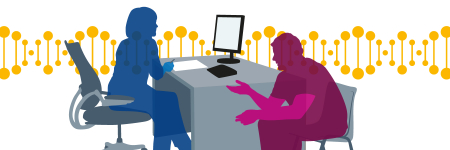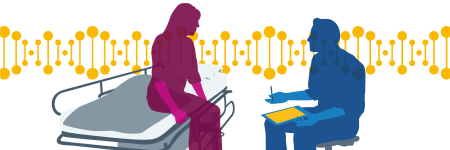Introduction
Genomics is becoming more and more relevant in ophthalmology. Increasingly, genomic testing supports diagnosis, and genomic information can also be used to guide decisions about management and screening. Understanding where genomics may be relevant, and ensuring that patients receive testing if they are eligible and could benefit from it, is therefore vital in providing the best care.
In this video, Dr Graeme Black uses examples from his own clinical practice at the Manchester Royal Eye Hospital to explore the progress that has been made in applying genomics in the field of ophthalmology.
What do I need to know?
Why is genomics important in ophthalmology?
Genomics plays a role in the rare eye conditions that are seen by all ophthalmologists from time to time, and provides opportunities in terms of management, diagnosis and screening. There are, broadly, two groups of inherited eye conditions:
- Rare eye conditions that are collectively important in ophthalmology and often present in children. These include congenital cataract, childhood glaucoma and inherited retinal disease, including macular dystrophies and retinitis pigmentosa.
- Later onset conditions, such as age-related macular disease and primary open-angle glaucoma, which also have a strong genetic basis.
Genomic – as opposed to genetic – testing (ie testing multiple genes at the same time) has rapidly improved diagnostic rates over recent years in ophthalmology.
Genomics is becoming increasingly important and testing should be offered to anyone who is eligible and would benefit. Patients with rare diseases are increasingly aware of the power of genomics to help them find a diagnosis.
Inherited eye disorders are highly heterogeneous. Using genomics to find a precise diagnosis for an individual can inform specific treatment and management, and determine whether or not family members should be tested and managed, too.
Case example: Leber congenital amaurosis
A precise molecular stratification of LCA allows for the identification of those individuals who are susceptible to systemic complications.
- Timothy was born with poor vision and was diagnosed with LCA. Genomic testing became available on the NHS when he was eight years old. Sequencing results demonstrated that he had a mutation in IQCB1, which is a gene that, when faulty, causes a form of LCA that is often complicated by renal disease and progressive renal failure.
- At that stage he was referred to the renal physicians, who found that his kidneys were scarred and their function severely compromised. He was going to require renal transplantation, which has a much better long-term outcome when undertaken prior to an individual being in acute renal failure. Within 12 months he had received a renal transplant from his mother.
- Here we can see that Timothy’s management was directed by genomic test results. Importantly, his family members are cared for appropriately in line with his genomic diagnosis, too. Timothy’s sister also has LCA and has poorly functioning kidneys, and is now being closely monitored by the paediatric renal service.
Read more about the use of gene editing for this condition.
Case example: Cerebrotendinous xanthomatosis
Around 30% of children with bilateral congenital cataract have an underlying syndromic diagnosis resulting in significant extraocular complications. Among these are a number of rare biochemical conditions that are hard to recognise in childhood, such as cerebrotendinous xanthomatosis.
Such disorders are potentially treatable, especially if recognised early. Genomic analysis enables improved identification of underlying causes of inherited forms of genetic cataract.
- Two brothers were found to have juvenile onset cataracts. They shared a complicated phenotype that was also associated with developmental delay and progressive behavioural difficulties.
- Genomic testing – performed after more than 20 other diagnostic tests, all found to be normal – efficiently enabled a diagnosis of cerebrotendinous xanthomatosis (CTX), a rare autosomal recessive genetic disorder caused by an abnormality in the CYP27A1 gene that results in a deficiency of the mitochondrial enzyme sterol 27-hydroxylase.
- CTX prevents cholesterol from being converted into a bile acid called chenodeoxycholic acid. Deposits of cholesterol and cholestanol (a cholesterol derivative) accumulate to cause progressive neurologic decline (such as seizures and ataxia) and early-onset coronary heart disease.
- Long-term therapy with chenodeoxycholic acid and statins was started; this can prevent the onset of the more severe disease features.
Looking to the future
Age-related macular disease: It is now well established that the aetiology of age-related macular disease (the commonest cause of visual disability in developed countries) has a very strong genetic basis. In the future, disease modification – either through treatment or through lifestyle modification – might make disease stratification from molecular analysis a possibility.
Primary open angle glaucoma: Large-scale population studies are helping to clarify the genetic contribution to POAG. In the future it is possible that this will be a valuable adjunct to early diagnosis and screening.
Treatments for rare diseases: Gene replacement therapies represent one of the most exciting opportunities for the treatment of genetic disease. Ophthalmology – specifically in the field of inherited retinal disease – is at the forefront of developments. In 2017, the FDA approved a gene replacement therapy for one form of LCA caused by mutations the in RPE65 gene. Clinical trials are under way for several other inherited retinal disorders, including choroideremia and X-linked retinitis pigmentosa.
Learning opportunities
Clinical resources
Identifying patients
Activity: Taking and drawing a genetic family history
Equip yourself with the knowledge and skills to construct a genetic pedigree.
Activity: Recognising the clinical clues of a genetic condition
Familiarise yourself with the clinical features of a range of genetic conditions










